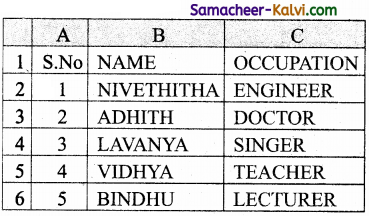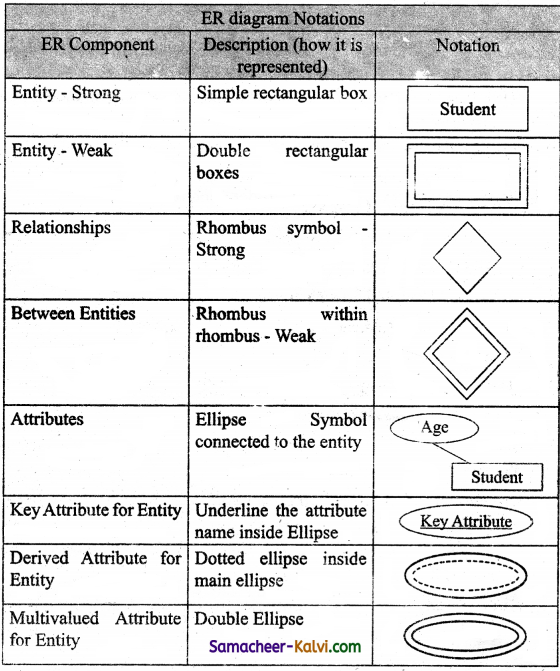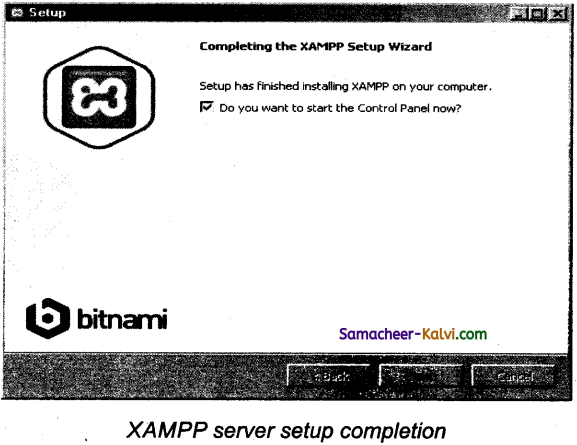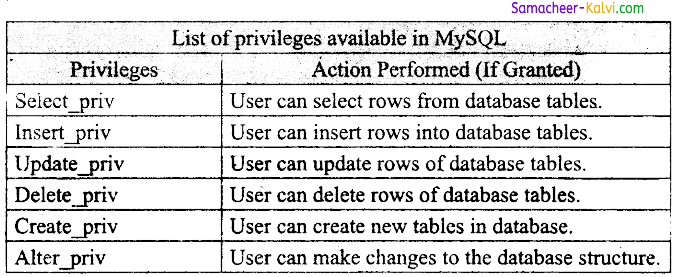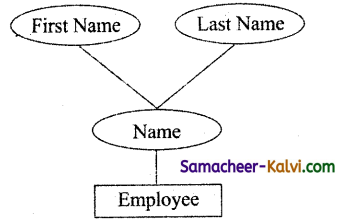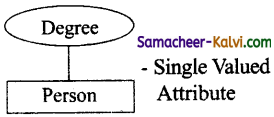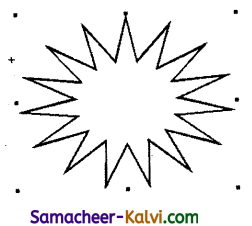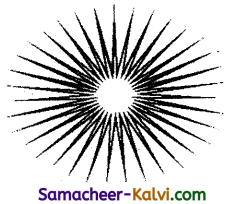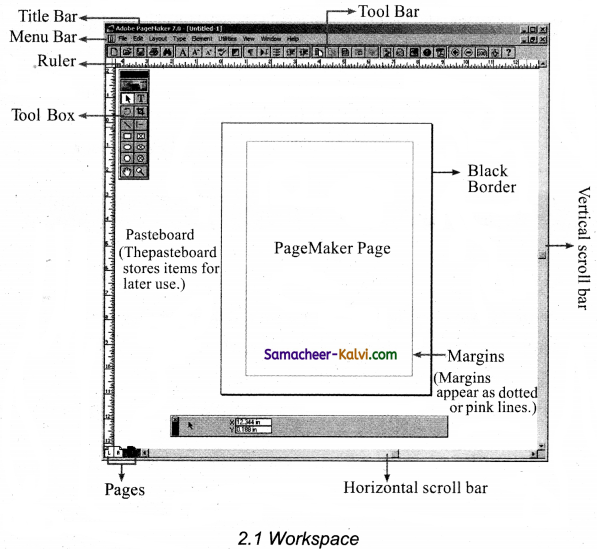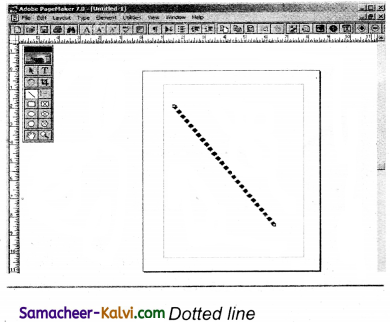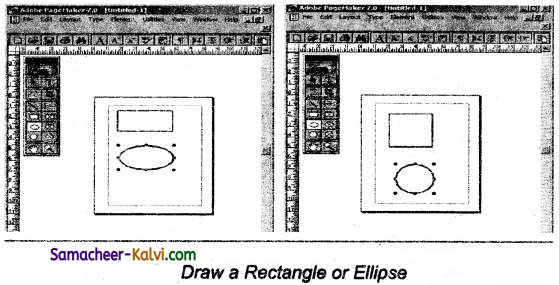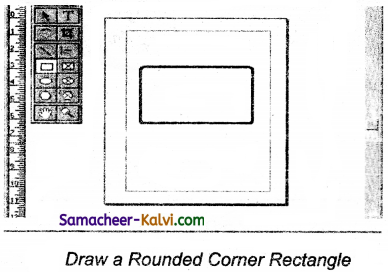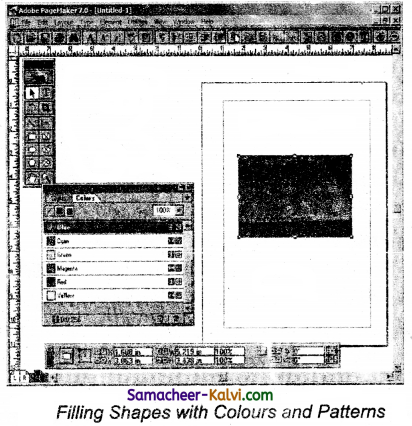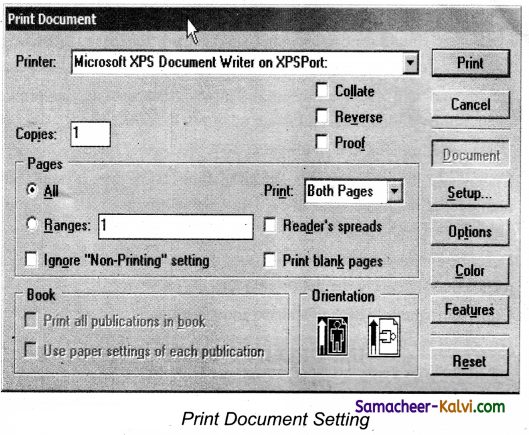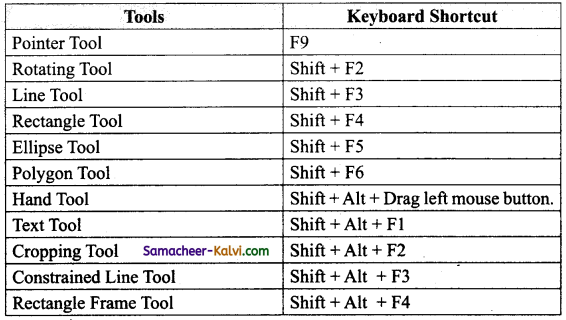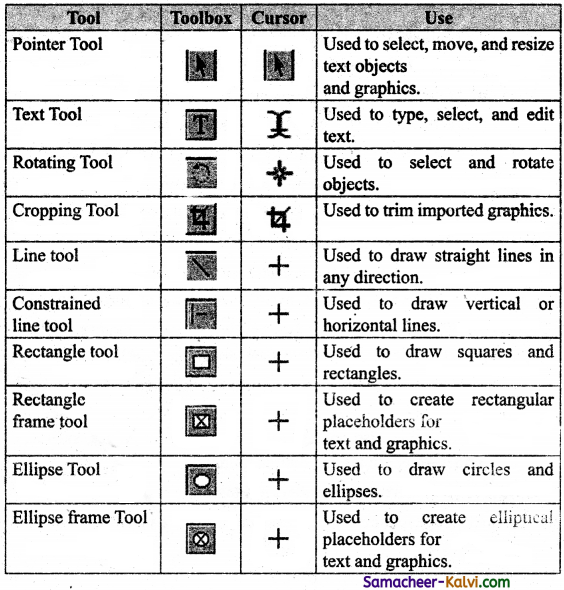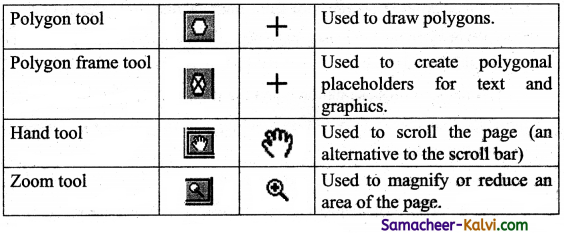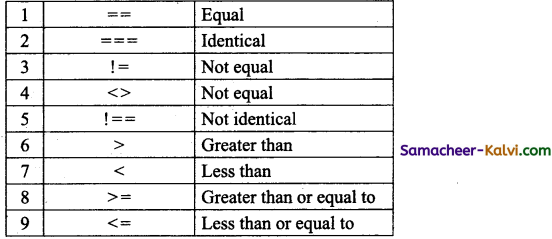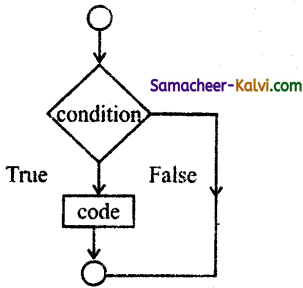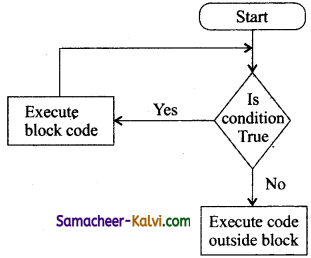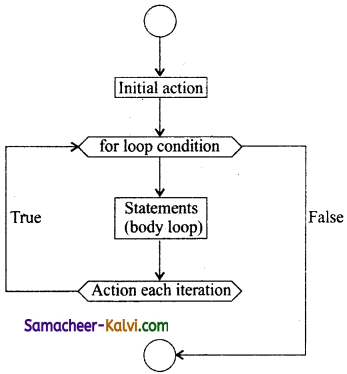TN State Board 12th Computer Science Important Questions Chapter 14 Importing C++ Programs in Python
Question 1.
What is a script language?
Answer:
A script language is a programming language for integrating and communicating with other programming language.
Question 2.
Write some of the most widely used script language?
Answer:
JavaScript, VBScript, PHP, Perl, Python, Ruby, ASP AND TCI.
![]()
Question 3.
What is called Garbage collection?
Answer:
- Python deletes unwanted objects (built- in types or class instances) automatically to free the memory space.
- The process by which python periodically frees and reclaims blocks of memory that no longer are in use is called Garbage collection.
Question 4.
What is a g++?
Answer:
g++ is a program that calls GCC (GNU C Compiler) and automatically links the required C++ library files to the object code.
Question 5.
What is the use ‘+’ in os.system ()?
Answer:
‘+’ in os.system ( ) indicates that all strings are concatenated as a single string and send that as a List.
![]()
Question 6.
What purpose of using GNUC compiler?
Answer:
g++ is a program that calls GCC (GNUC Compiler) and automatically links the required C++ library files to the object code.
Question 7.
What is a command for wrapping C++ code?
Answer:
if _name_ = = ‘_main_’:
main (Sys. argv [1:])
Question 8.
Write the syntax of os.system ( ).
Answer:
The syntax of os.system ( ) is
os.system (‘g++’ + <variable_namel>
‘ – <mode>’ + <variable_name 2>)
Question 9.
Write the syntax of getopt ( ).
Answer:
The syntax of getopt ( ) is
<opts>, <args> = getopt. getopt (argv, options, [long_options])
![]()
Question 10.
Differentiate static and dynamic language.
Answer:
| Static | Dynamic |
| A static typed language like C++ requires the programmer to explicitly tell the computer what data type, each data value is going to use. | A dynamic typed language like python does not require the data type to be given explicitly for the data. Python manipulate the variable based on the type of value. |
Question 11.
Write the steps to executing C++ program through python.
Answer:
- Double click the run terminal of MinGW.
- Go to the folder where the python software is located, For example Python is folder is located in.
- c:\program files\open office 4\python
Question 12.
Write the modular program in python to find factorial of given number.
Answer:
def fact (n):
f= 1
if n == 0:
return 0
elif n = 1:
return 1
else :
for i in range (1, n+1):
f=f*i
print (f)
![]()
Question 13.
Write a note on main (sys.argv [1]).
Answer:
- main (sys.argvfl]) – Accepts the python program and input file (C++ file) as a list (array).
- argv [0] contains the python program which is need not to be passed because by default _main_ contains source code reference
- argv [1] contains the name of the C++ file which is to be processed.
Question 14.
What are the commonly used interfaces when importing C++ files in python?
Answer:
- Python-C-API: (API-Application Programming Interface for interfacing with C programs)
- Ctypes (for interfacing with c programs)
- SWIG (Simplified Wrapper Interface Generator- Both G and C++)
- Cython (Cython is both a Python-like language for writing C-extensions)
- Boost.Python (a framework for interfacing Python and C++)
- MinGW (Minimalist GNU for Windows)
Question 15.
Write the syntax of os,system ()? Explain the arguments.
Answer:
The os module allows you to interface with the windows operating system where python is running on.
The syntax is
os.system (‘g++’ + <variable__namel> ‘-<mode>’ + <variable_name2>
Where
os.system – function system (defined in os module).
g++ – General compiler to compile C++ program under windows operating system.
Variable_name1 – Name of the C++ file without 1 extension.cpp in string format.
mode – To specify input or output mode. Here it is ‘mode’ prefixed with hyphen.
Variable_name2 – Name 0f the executable file without extension.exe in string format.
Eg:
os.system (‘g++’ + cpp_file + ‘-o’ + exe_file)
![]()
Question 16.
Write a C++ program to print Transpose of matrix (2D array). And save the file as transpose.py. Program that compile and execute in python.
Answer:
//Now select File→New in Notepad and type the C++ program.
#include <iostream>
using namespace std
int main( )
{
int a[3][3], i, j;
for(i=0; i<3; i++)
{
for(j=0; j<3; j++)
{
cout<<“enter the value for array[“<<i+1 <<”]”<<“[“<<j+1<<”] :”;
cin>>a[i][j];
}
}
system(“cls”);
cout<<“\n\nOriginal Array\n”;
for(i=0; i<3; i++)
{
for(j=0; j<3; j++)
cout<,a[i][j]<<‘
cout<<endl;
}
cout<<“\n\n The Transpose of Matrix\n”;
for (int i = 0; i < 3; i++)
{
for (int j = 0; j < 3; j++)
cout<<a[j][i]<<‘ ‘;
cout<<endl;
}
return 0;
}
import sys, os, getopt
def main(argv):
cppjile = “
exefile – ”
opts, args – getopt.getopt(argv, “i:”,[‘ifile=’])
for o, a in opts:
if o in (“-i”, ifile”):
cpp_file = a+‘.cpp’
exe_file – a + ‘.exe’
run(cpp_file, exe_file)
def run(cpp_file, exe_file):
print(“Compiling ” + eppfile)
os.system(‘g++ ’ + cpp_file + ‘ -o ’ + exe_ file)
print(“Running ” + exefile)
print(“———-”)
print
os.system(exe_file)
print
if_name_main
main(sys.argv[l:])
![]()
Question 17.
Write a C++ program containing functions and executing by python program.
Answer:
/*Write a C++ program using a user defined function to function cube of a number.*/
//Now select File—>New in Notepad and type the C++ program
#//include <iostream>
using namespace std;
// Function declaration
int cube(int num);
int main()
{
int num;
int c;
cout<<”Enter any number: “<<endl;
cin>>num;
c = cube(num);
Cout<<”Cube of “ <<num<< “ is “<<c;
return 0;
}
//Function to find cube of any number
int cube(int num)
{
return (num * num * num);
}
// Save this file as cubefile.cpp
#Now select File → New in Notepad and
type the Python program
# Save the File as fun.py
# Program that compiles and executes a .cpp file
# Python fun.py -i c:\pyprg\cube_file.cpp
import sys, os, getopt
def main(argv):
cpp_file =’ ‘
exe_file =‘ ’
opts, args – getopt.getopt(argv, “i:”,[‘ifile=’])
for o, a in opts:
if o in (“-i”, ifile”):
cpp_file = a + ‘.cpp’
exe_file = a + ‘.exe’
run(cpp_file, exe file)
def run(cpp_file, exe_file):
print(“Compiling “ + cppfile)
os.system(‘g++ ‘ + cpp_file + ‘ -o ‘ + exe_ file)
print(“Running “ + exe file)
print(“———-”)
print
os.system(exe_file)
print
if_name_==_main_’:
main(sys.argv[l:])
Output of the above program
Compiling e:\pyprg\cube_file.cpp
Running c:\pyprg\cube_file.exe
——————-
Enter any number:
5
Cube of 5 is 125
![]()
Question 18.
Write a C++ program to implement multilevel inheritance of a class and executing by python program.
Answer:
// C++ program to implement Multilevel Inheritance
//Now select File—>New in Notepad and type the C++program
//include <iostream>
using namespace std;
#base class
class Vehicle
{
public:
Vehicle( )
{
cout<< “This is a Vehicle” <<endl;
}
};
class threeWheeler: public Vehicle
{public:
three Wheeler( )
{
cout<<”Objects with 3 wheels are vehicies”<<endl;
}
};
// sub class derived from two base classes
class Auto: public threeWheeler{
public:
Auto( )
{
cout<<”Auto has 3 Wheels”«endl;
}
};
// main function int main( )
{
//creating object of sub class will invoke the constructor of base classes
Auto obj;
return 0;
}
// Save this file as inheri cpp.cpp
//Now select File → New in Notepad and type the Python program
# Save the File as classpy.py
# Python classpy.py -i inheri_cpp command to execute C++ program
import sys, os, getopt
def main (argv):
cpp_file = ‘ ’
exe_file = ‘ ’
opts, args = getopt.getopt (argv, “i:”,[‘ifile=’])
for o, a in opts:
if o in (“-i”, “-ifile”):
cpp_ file = a + ‘.cpp’
exe_file = a + ‘.exe’
run (cpp_file, exefile)
def run(cpp_file, exe file):
print (“Compiling “ + cpp_file)
os.system (‘g++ ‘ + cpp_file + ‘ -o ‘ + exe_ file)
print (“Running “ + exe_file)
print (“————-”)
print
os.system (exe_file) print
if_name_==’_main_’:
main (sys.argv[1:])
Output of the above program
Compiling c:\pyprg\class_file.cpp
Running c:\pyprg\class_file.exe
—————-
This is a Vehicle
Objects with 3 wheels are vehicles
Auto has 3 Wheels
![]()
Question 19.
What is the theoretical difference between Scripting language and other programming language?
Answer:
|
Scripting language |
Other languages (Programming language) |
| A script language requires an interpreters. | Programming language requires a compiler. |
| A script language do not require the compilation step and are rather interpreted. | But programming languages needs to be compiled before running. |
| Example: Javascript, python etc., | Example: C++, COBOL etc., |
Question 20.
Differentiate compiler and interpreter.
Answer:
| Compiler |
Interpreter |
| Compile the entire program and translates it as a whole machine code. | Interpreter translates program one statement at a time. |
| It takes large amount of time to analyze the source code but execution time is faster. | It takes less amount of time to analyze the source code, and execution time is slower. |
| Example for C, C++ use compilers. | Example for python, Javascript use interpreters. |
![]()
Question 21.
Write the expansion of
(i) SWIG
(ii) MinGW
Answer:
(i) SWIG – Simplified Wrapper Interface Generation.
(ii) MinGW – Minimalist GNU for windows.
Question 22.
What is the use of modules?
Answer:
- We use modules to breakdown large programs into small manageable and organized files.
- Modules provides reusability of code.
- We can define our most used functions in a module and import it, instead of copying their definitions into different programs.
Question 23.
What is the use of cd command. Give an example.
Answer:
In python use cd command Hold Shift + Right click in explorer in the folder where the python file is will create a proper path string for your OS.
Eg. Using cd command in python
>>>import OS
>>>OS.system (“cd c:\mydir”)
![]()
Question 24.
Differentiate PYTHON and C++.
Answer:
|
PYTHON |
C++ |
| Python is typically an “interpreted” language. | C++ is typically a “compiled” language. |
| Python is a dynamic typed language. | C++ is compiled statically typed language. |
| Data type is not required while declaring variable. | Data type is required while declaring variable. |
| It can act both as scripting and general purpose language. | It is a general purpose language. |
Question 25.
What are the applications of scripting language?
Answer:
Applications of scripting Languages:
- To automate certain tasks in a program.
- Extracting information from a data set.
- Less code intensive as compared to traditional programming language..
- Can bring new functions to applications and give complex systems together.
Question 26.
What is MinGW? What is its use?
Answer:
- MinGW – (Minimalist GNU for windows), it refers to a set of runtime header files, used in compiling and linking the code of C,C++ and FORTRAN to be run on windows operating system.
- It uses to compile and execute the C++ program.
- MinGW allows to compile execute the C++ program dynamically through python program using g++.
- MinGW – W64 is the best compiler for C++ on windows.
![]()
Question 27.
Identify the module, operator, definition name for the following weleome.display ( )
Answer:
Welcome.display ( )
welcome – module
Dot – Dot operator
display ( ) – Function name
Question 28.
What is sys.argv? What does it contain?
Answer:
- sys.argv is the list of command – line arguments passes to the python program.
- argv contains all the items that come along via the command-line input, It’s basically an array holding the command-line arguments of the program.
- The first argument, sys.argv[0], is always the name of the program as it was invoked, and sys.argv [1] is the first argument you pass to the program.
Question 29.
Write any 5 features of Python.
Answer:
Features of Python over C++:
- Python uses Automatic Garbage Collection whereas C++ does not.
- C++ is a statically typed language, while Python is a dynamically typed language.
- Python runs through an interpreter, while C++ is pre-compiled.
- Python code tends to be 5 to 10 times shorter than that written in C++.
- In Python, there is no need to declare types explicitly where as it should be done in C++.
- In Python, a function may accept an argument of any type, and return multiple values without any kind of declaration beforehand. Whereas in C++ return statement can return only one value.
![]()
Question 30.
Explain each word of the following command.
Answer:
Python <filename.py> -<i> <C++ filename
without cpp extension>
- Python – Keyword to execute the python program from command-line.
- filename.py – Name of the python program to executed.
- -i – input mode
- C++ filename without cpp extension- name of C++ file to be compiled and executed.
Question 31.
What is the purpose of sys,os,getopt module in Python.Explain.
Answer:
(i) sys module:
This module provides access to
some variables used by the interpreter and to functions that interact strongly with the interpreter, sys.argv is the list of command-line argument passed to the python program.
(ii) OS module:
The OS module in python provides a way of using operating system dependent functionality, os.system ( ) – execute the C++ compiling command in the shell.
(iii) get opt module:
The getopt module of python helps you to parse (split) command-line options and arguments.
getopt.getopt method parses command¬’ line options and parameter list.
![]()
Question 32.
Write the syntax for getopt( ) and explain its arguments and return values.
Answer:
The getopt module of python helps you to parse command-line options and arguments.
The syntax is
<opts>,<args> = getopt.getopt (argv, options, [long-options])
Where,
argv- This is the argument list of values to be parsed (splited).
In our program the complete command will be passed as a list.
Options:
This is string of options letters that the python program recognize as for input or for output with options (T or ‘0’) that follower by a colon (:).
Here colon is used to denote the mode.
long-options. This parameter is passed with a list of strings.
Argument of long options should be followed ^ by an equal sign (‘=’).
getopt( ) method returns value consisting of two elements.
Each of these values are stored separately in two different list (arrays) opts and orgs.
Eg:
opts, args = getopt.getopt (argv,”i:”, [‘ifile=’]) Where
opts – [(‘-i’, ‘c:\\pyprg\\p4’)
‘c:\\pyprg\\p4’ – Value, absolute path.
![]()
Question 33.
Write a Python program to execute the following C++ coding.
Answer:
#include <iostream>
using namespace std;
int main( )
{
cout<<“WELCOME”;
return(0);
}
The above C++ program is saved in a file welcome.cpp
import sys, Os, get opt
def main (argv)
cpp_file = 11
exe_file =11
opts, args = etopt.getopt(argv, “i:”, [‘i file=’] for 0, a in (“-1”, “ i file”):
if 0, in opts:
cpp_file = a + ‘.cpp’
exe_file = a + ‘.exe’
run(cpp_file, exe_file)
def run (cpp file, exe file):
print(“compiling”+cpp_file)
Os.system (‘g++’ +cpp file + ‘ – 0’ + exe_file)
print (“Running” + exefile)
print
Os.system (exe file)
print
if_name_== ‘_main_’: main (sys.argv[l:])
![]()
Question 34.
Write a C++ program to create a class called Student with the following details.
Answer:
Protected member
Rno integer
Public members
void Readno(int); to accept roll number and assign to Rno
void Writeno( ); To display Rno.
The class Test is derived Publically from the Student class contains the following details.
Protected member
Mark1 float
Mark2 float
Public members
void Readmark(float, float); To accept mark1 and mark2
void Writemark( ); To display the marks
Create a class called Sports with the following detail
Protected members
score integer
Public members
void Readscore(int); To accept the score
void Writescore( ); To display the score
The class Result is derived Publically from Test and Sports class contains the following details
Private member
Total float
Public member
void display( ) assign the sum of mark1, mark2, score in total.
invokeWriteno( ), Writemark( ) and
Writescore( ). Display the total also.
Save the C++ program in a file called hybrid.
Write a python program to execute the hybrid.cpp
# include <io stream.h>
# include <conil.h>
class student
{
private:
char name [30];
int Rno;
Float mark1, mark2, Total_marks;
protected;
void Readmark ( )
{
cout <<“\n Type name, Roll no, markl, mark2”;
cin>>Rno>>Name>>mark1>>mark2;
}
void writescore ( )
{
Total marks = mark1 + mark2;
}
void writemark ( )
{ .
cout <<“\n Name” <<name;
cout <<“\n Roll No” <<Rno;
cout <<“\n Mark 1” <<mark1;
cout <<“\n Mark 2” <<mark2;
cout <<“\n Total_marks” <<Total_marks;
}
public:
student ( )
{
name [0] = ‘\o’;
Rno = mark1 = mark2 = totalmarks 0;
}
void execute ( );
{
Read mark ( );
Write score ( );
Write mark ( );
}
};
void main ( )
{
clrscr ();
student stud;
stud.execute ();
}
// save This file as hyprid.cpp
// Write python program to execute hyprid.Answer:
cpp in python
import sys, os, getopt
def main (argv):
cpp_file = “
exe_file = ”
opts, args = getopt.getopt(argv, “i:”,[ifile =])
for o, hyprid in opts:
if o in (“-i”, “–file”):
cpp_file = hyprid + ‘.cpp’
exe_file = hyprid + ‘.exe’
run (cpp_file, exe_file)
def run (cpp_file, exe_file):
os.system(‘g++’ + cpp_file + ‘-o’ + exe_file)
os.system (exe_file)
print
if name = ‘_main_’:
main (sys.argv [1:])
![]()
Question 35.
Write a C++ program to print boundary elements of a matrix and name the file as Border.cpp
Answer:
// C++ program to print boundary element
// ot.matrix
# include <bits/studc++.h>
Using namespace std;
Const int MAX = 100;
void print Boundary (int a [ ][MAX],
int m, int n
{
for (int i = 0; i < m; i++)
{
for (int j = 0; j<n; j++)
{
if (i ==0 || j == 0|| i == n – 1 || j == n – 1)
cout <<a[i] [j] << “ ”;
else
cout<<“ ”
<<“ ”;
}
cout <<“\n”;
}
}
int main ( )
{
int a [4] [MAX] = {{1, 2, 3, 4}, {5, 6, 7, 8}, {1,2, 3, 4}, {5,6, 7, 8}};
return 0; }
// To save this C++ program as Border.cpp
Write a python program to Border.cpp
import sys, os, getopt
def main (argv):
cPP_file=“
exe_file =”
opts, args = getopt.getopt (argv, for O, Border in opts:
if 0 in (‘-1”, “- -file”):
cpp-file = Border + ‘.cpp’
exe-file = Border + ‘.exe’
run cpp_file, exe_file)
def run (cpp_file, exe_file):
os.system (“g++” + cpp_file + ‘-0’ + exe_file)
os.system (exe_file)
if_name_ == ‘_main_’:
main (sys.argv [1:])
![]()
Choose the best answer:
Question 1.
Python is mostly used as a …………… language.
(a) High level
(b) Scripting
(c) glue
(d) B or C
Answer:
(d) B or C
Question 2.
What is the name called, python deletes unwanted objects automatically to free the memory space?
(a) Recycle
(b) Garbage collection
(c) Interface
(d) Wrapping
Answer:
(b) Garbage collection
Question 3.
Which mode is specify to input or output in python?
(a) ‘-o’
(b) ‘-i’
(c) ‘-a’
(d) ‘-s’
Answer:
(a) ‘-o
![]()
Question 4.
Which method is used to returns values ‘ consisting of two values?
(a) append ( )
(b) extend ( )
(c) getopt ( )
(d) insert ( )
Answer:
(c) getopt ( )
Question 5.
Which interface is used for python-like language for writing c-extensions?
(a) Cython
(b) Boost
(c) SWIG
(d) MinGW
Answer:
(a) Cython
Question 6.
Match the following:
| (i) Python | A. for windows |
| (ii) C++ | B. wrapper interface |
| (iii) SWIG | C. dynamic language |
| (iv) MinGW | D. Statical language |
(a) (i) – C, (ii) – D, (iii) – B, (iv) – A
(b) (i) – C, (ii) – B, (iii) – A, (iv) – D
(c) (i) – B, (ii) – A, (iii) – D, (iv) – C
(d) (i) – D, (ii) – A, (iii) – C, (iv) – B
Answer:
(a) (i) – C, (ii) – D, (iii) – B, (iv) – A
![]()
Question 7.
Choose the incorrect pair:
| Column – I | Column – II |
| (a) Python | interpreted |
| (b) C++ | Compiled |
| (c) TCI | High level language |
| (d) ASP | Script language |
Answer:
(c)
Question 8.
Choose the correct pair:
| Column – I | Column – II |
| (a) stud.py | module |
| (b) sys.argv | getopt module |
| (c) os.system | sys module |
| (d) getopt | A variable |
Answer:
(a)
Question 9.
Choose the incorrect statement.
(a) Python is typically a compiled language.
(b) Python is a dynamic typed language.
(c) In python, Data type is not required while declaring variable.
(d) Python is a script and general purpose language.
Answer:
(a) Python is typically a compiled language.
Question 10.
Choose the correct statement.
(a) Sys module provides access to variable used by the compiler.
(b) sys.argv is the list of command-line arguments passed to the python program,
(c) Python has no standard (Built in) modules.
(d) Module does not provide reusability of code.
Answer:
(b) sys.argv is the list of command-line arguments passed to the python program
![]()
Question 11.
Assertion (A):
Python is actually an interpreter, high level, general-purpose programming language.
Reason (R):
It can be used for processing text, numbers, images, scientific data and just about anything else you might save on a i computer.
(a) Both A and R are True, And R is the correct explanation for A.
(b) Both A and R are True, But R is not the correct explanation for A.
(c) A is true but R is false.
(d) A is false but R is true.
Answer:
(a) Both A and R are True, And R is the correct explanation for A.
Question 12.
Assertion (A):
Modular programming is a software design technique to split your code into separate parts.
Reason (R):
Python has number of standard (Build-in) modules.
(a) Both A and R are True, And R is the correct explanation for A.
(b) Both A and R are True, But R is not the correct explanation for A.
(c) A is true but R is false.
(d) A is false but R is true.
Answer:
(b) Both A and R are True, But R is not the correct explanation for A.
Question 13.
Pick the odd one out.
(a) TCI
(b) ASP
(c) Ruby
(d) Java
Answer:
(d) Java
![]()
Question 14.
Which language is used both as scripting and general purpose language?
(a) C
(b) C++
(c) Python
(d) HTML
Answer:
(c) Python
Question 15.
Which programming language is designed for integrating and communicating with other programming language?
(a) Modular language
(b) Procedural language
(c) Scripting language
(d) High level language
Answer:
(a) Modular language
Question 16.
Which of the following is not a scripting language?
(a) Ruby
(b) TCI
(c) ASP
(d) COBOL
Answer:
(d) COBOL
![]()
Question 17.
Which requires a programming language?
(a) Compiler
(b) Interpreter
(c) Editor
(d) Exefile
Answer:
(a) Compiler
Question 18.
Which is requires a scripting language?
(a) Compiler
(b) Interpreter
(c) Editor
(d) Exefile
Answer:
(b) Interpreter
Question 19.
Which of the following interface used for interfacing with C programs?
(a) Cython
(b) Ctypes
(c) MinGw
(d) SWIG
Answer:
(b) Ctypes
![]()
Question 20.
Which of the following python interface used for both C and C++?
(a) Cython
(b) Ctypes
(c) MinGw
(d) SWIG
Answer:
(d) SWIG
Question 21.
Which is needed to run a C++ program on windows?
(a) m++
(b) g++
(c) e++
(d) f++
Answer:
(b) g++
Question 22.
Which of the following is not a python module?
(a) sys
(b) g++
(c) os
(d) Getopt
Answer:
(b) g++
![]()
Question 23.
Which version of MinGw is the best compilerfor C++ on windows?
(a) W32
(b) W64
(c) W128
(d) W256
Answer:
(a) W32
Question 24.
Which interface to a set of runtime headerfiles, used compiling and linking the code of C, C++?
(a) SWIG
(b) MinGw
(c) Cython
(d) Ctypes
Answer:
(b) MinGw
Question 25.
g++ is a
(a) module
(b) program
(c) scope
(d) identifier
Answer:
(b) program
![]()
Question 26.
Which command is used to clear the screen in window?
(a) els
(b) clear
(c) cs
(d) cl
Answer:
(a) els
Question 27.
Which operator is used to access the function?
(a) (.) dot
(b) (:) colon
(c) (,) comma
(d) (;) semi colon
Answer:
(a) (.) dot
Question 28.
Which is mostly used as a ‘glue’ language?
(a) C
(b) C++
(c) Java
(d) Python
Answer:
(d) Python
![]()
Question 29.
Which of the following is not a scripting language?
(a) JavaScript
(b) PHP
(c) Perl
(d) HTML
Answer:
(d) HTML
Question 30.
Importing C++ program in a Python program is called:
(a) wrapping
(b) Downloading
(c) Interconnecting
(d) Parsing
Answer:
(a) wrapping
Question 31.
The expansion of API is:
(a) Application Programming Interpreter
(b) Application Programming Interface
(c) Application Performing Interface
(d) Application Programming Interlink
Answer:
(b) Application Programming Interface
![]()
Question 32.
A framework for interfacing Python and C++ is:
(a) Ctypes
(b) SWIG
(c) Cython
(d) Boost
Answer:
(d) Boost
Question 33.
Which of the following is a software design technique to split your code into separate parts?
(a) Object oriented Programming
(b) Modular programming
(c) Low Level Programming
(d) Procedure oriented Programming
Answer:
(b) Modular programming
Question 34.
The module which allows you to interface with the Windows operating system is:
(a) OS module
(b) sys module
(c) csv module
(d) getopt module
Answer:
(a) OS module
![]()
Question 35.
getopt( ) will return an empty array if there is no error in splitting strings to:
(a) argv variable
(b) opt variable
(c) args variable
(d) ifile variable
Answer:
(c) args variable
Question 36.
Identify the function call statement in the following snippet.
if _name _ ==‘_main_
main(sys.argv[l:])
(a) main(sys.argv[l:])
(b) _name_
(c) _main_
(d) argv
Answer:
(c) main
Question 37.
Which of the following can be used for processing text, numbers, images, and scientific data?
(a) HTML
(b) C
(c) C++
(d) PYTHON
Answer:
(d) PYTHON
![]()
Question 38.
What does name contains ?
(a) C++ filename
(b) main( ) name
(c) python filename
(d) os module name
Answer:
(d) os module name
